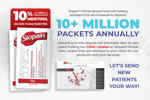
The Power of Menthol: Why I...
VIEW >

Chiropractor’s Guide to Inc...
VIEW >

Not yet a Pro Portal member? Sign up here.
Chiropractors, Physical Therapists, Massage Therapists and other Hands-On Healthcare Professionals are an essential health and wellness resource for individuals of all ages. We partner closely with these professionals on helping people perform better and move ‘pain-free’.
Our topical pain relief products were specifically formulated with these hands-on healthcare professionals (and their patients) in mind. Our fast-acting formulation with penetration enhancers plus 10% menthol, MSM, Glucosamine is like no other. Embracing hands-on healthcare professionals and topical pain relief solutions like Stopain® Clinical provides patients and their families with the ultimate wellness solution.
Visit our clinic locator to find a healthcare professional in your community.
Collaborating closely with our fellow manufacturers, industry associations, and clinical educators, the Points of Relief Blog delivers clinical insights, emerging trends, and best practices with the ultimate goal of helping you and your patients move “pain-free” and perform better.

If you are searching for a pain relief gel, cream, or ointment, you are not alone. Millions of people experience muscle aches, joint pain, and chronic conditions like arthritis daily. Finding a fast-acting, long-lasting solution is essential for maintaining an active and pain-free lifestyle.
One of the most effective ingredients in... VIEW FULL ARTICLE

In a competitive healthcare landscape, chiropractors need effective ways to attract new patients and enhance treatment outcomes. One strategy that can set your practice apart is incorporating high-quality topical pain relief products like Stopain Clinical into your treatment approach. These products not only help patients manage pain effectively but also... VIEW FULL ARTICLE

Troy Healthcare, the maker of Stopain Clinical topical analgesic, has partnered with leading industrial first aid and workplace health companies to dispense more than 10 million pain relief gel sample packets annually.
This initiative aims to introduce Stopain Clinical samples to millions of individuals in workplace... VIEW FULL ARTICLE

In 2017, the owners of Troy Healthcare set out on a top-secret mission to develop the best topical pain relief solution for hands-on healthcare professionals (and their patients). They determined through the counsel of industry leading bodywork technicians that the ‘topical’ needed to perform well with the therapist’s hands and... VIEW FULL ARTICLE